Service Alert
July 1 - Canada Day
CELA will be closed on Tuesday, July 1st for Canada Day. Our office will reopen and our Contact Centre services will resume on Wednesday, July 2nd. Enjoy your holiday!
CELA will be closed on Tuesday, July 1st for Canada Day. Our office will reopen and our Contact Centre services will resume on Wednesday, July 2nd. Enjoy your holiday!
Showing 61 - 80 of 1499734 items
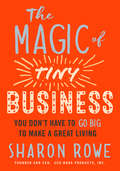
By Sharon Rowe. 2018
"This is a powerful book—tiny is mighty. Sharon Rowe's simple shift in thinking is a profound idea, precisely what we…
need to hear."—Seth Godin, author of LinchpinToo many of us feel trapped by work that keeps us from living our purpose. We fantasize about starting our own business, yet we're warned against falling into debt, working eighty hours a week, and coping with the pressure to grow. Eco-Bags Products founder Sharon Rowe says there's another way: go tiny. Like a tiny house, a tiny business is built on maintaining a laser focus on what is essential by living an intentional life. As an entrepreneur and mother, Rowe is most concerned with putting family first, maintaining financial security, and doing something that makes an impact in the world. Using the success story of Eco-Bags Products, Rowe distills the step-by-step process of building a profitable, right-scaled, sustainable venture that doesn't compromise your values. She shows you how to test your concept, manage your money and priorities, and more, while staying true to the "tiny" ethos.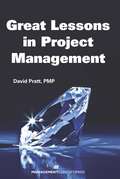
By David Pratt Pmp. 2015
Learn from Other Projects to Avoid Pitfalls on Your Projects!Projects fail at an alarming rate, whether they are information technology,…
training, construction, or policy development projects. No matter the focus, each year we experience an abundance of challenged projects that either require super-human effort to resuscitate or die an untimely death.Great Lessons in Project Management is a treasure trove of lessons learned from troubled projects—and from projects that went well. This collection of stories describes the events surrounding a particular challenge a project manager faced or a tool that another used effectively. Project managers of all types of projects can draw on these stories to validate their own good practices and to avoid the pitfalls so many have encountered on their projects.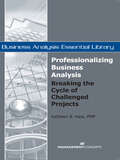
By Kathleen B. Hass PMP. 2008
A Volume of the Business Analysis Essential Library Series Uncover the role of the business analyst as the business and…
technology strategist who provides the executive leadership team with the information, process, tools, and capability to make the best decisions. The Business Analyst as Strategist: Translating Business Strategies into Valuable Solutions outlines the first two phases of the business solution life — strategic planning and enterprise analysis –– that the future vision of the enterprise is established, strategic goals and measures are set, and the most viable programs and supporting projects are initiated to achieve the strategy. Learn how to set the stage for change, and how to translate your strategy into operational terms through a portfolio of programs and supporting projects. Understand the five-step process to set well-formed strategies and how to execute them. Through this book you will master business analysis competencies, learn how to react effectively, anticipate changes in the marketplace, and flow value through the enterprise to the customer, thus achieving competitive advantage.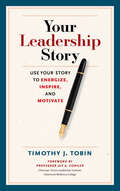
By Tim Tobin. 2015
Stories have power. They move people in a way that facts and figures can't. Many leaders use stories as a…
tool, but leadership development expert Tim Tobin says most have no idea what tale their own leadership is telling. He shows how, by thinking of your career as a narrative-with a plot, characters, and an arc-you can increase your awareness of yourself as a leader and become more effective, insightful, and inspiring. Using story as both a metaphor and a process for self-development, Tobin offers activities and questions that help you better understand your own leadership and how others perceive it. What is the plot of your leadership story-your overall goals and purpose? Who are the main characters and what roles do they play? How have the settings of your story influenced it? What are the conflicts that you need to resolve to move toward the ending you intend? But you have to share your story to make it an effective leadership tool. Tobin gives detailed advice on framing your message, finding ways to communicate it, and understanding the role others play in furthering that message. If you don't tell your leadership story, other people will-and it may not be the story you want told. Taking control of your leadership story enables you to more consciously shape the impact you have in the world. You'll be better equipped to make decisions, choose actions that tell the story you want to tell, make stronger connections to those you lead, and ensure that you become the kind of leader you want to be.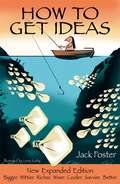
By Jack Foster, Larry Corby. 2001
This new expanded second edition is an international bestseller with over 200,000 copies sold and translated into 15 languages that…
shows you—no matter your age or skill, your job or training—how to come up with more ideas, faster and easier. Jack Foster's simple five-step technique for solving problems and getting ideas takes the mystery and anxiety out of the idea-generating process. It's a proven process that works. You'll learn to condition your mind to become "idea-prone," utilize your sense of humor, develop your curiosity, visualize your goals, rethink your thinking, and overcome your fear of rejection. This expanded edition of the inspiring and enlightening classic features new information on how to turn failures to your advantage and how to create a rich, idea-inducing environment. Dozens of new examples and real life stories show that anyone can learn to get more and better ideas.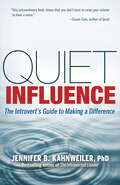
By Jennifer B. Kahnweiler. 2013
Introverts may feel powerless in a world where extroverts seem to rule, but there's more than one way to have…
some sway. Jennifer Kahnweiler proves introverts can be highly effective influencers when, instead of trying to act like extroverts, they use their natural strengths to make a difference. Kahnweiler identifies six unique strengths of introverts and includes a Quiet Influence Quotient (QIQ) quiz to measure how well you're using these six strengths now. Then, through questions, tools, exercises, and powerful real-world examples, you will increase your mastery of these strengths.
By Ginger Levin PMP, DPA, Parvis F. Rad PhD, PMP. 2005
Your Complete Guide to Project Management Metrics is Here!Metrics for Project Management: A Formalized Approach describes a comprehensive set of…
project management metrics in an easy-to-read format. Through a unique presentation of metrics through the categories of "things," "people," and "enterprise," you'll learn how metrics can:• Guide you toward informed decisions• Help the enterprise recognize the sum of its collective capabilities• Ensure that plans for producing and delivering products and services are consistently realistic, achievable, and attainable• Link the efforts of individual team members with the overall success of the project• Indirectly promote teamwork and improve team morale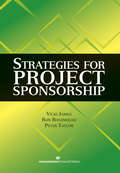
By Peter Taylor, Vicki James, Ron Rosenhead. 2013
Optimize the Role of the Project Sponsor The project sponsor is critical to project success, yet it is a role…
that is often assigned to a member of the organization with little knowledge or training in project management practices. This creates challenges not only for the sponsor but for the project manager. The organization suffers too if key members of the project team are not fully utilized, as valuable resources are wasted. In Strategies for Project Sponsorship, the authors address this challenge from all three vantage points—that of the project manager, the project sponsor, and the organization. Based on their practical experience and solid research, they offer practical methods that project manager s can use to optimize the participation of the sponsor. They also offer clear and straightforward guidance for project sponsors on how to properly execute their duties and contribute to project success. Executives will gain valuable perspective on the organization's projects and key players. From defining the roles and responsibilities of the project sponsor to suggesting specific practices that maximize the working relationship between the sponsor and project manager, this book is the ultimate guide. Examples from real-world sponsor experiences, as well as tips, techniques, and tools, enhance its applicability and practicality. This book should be given to every newly assigned project sponsor, read and referred to by every project manager, and on the desk of every organizational executive as a reference.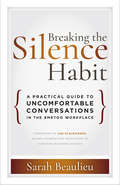
Top consultant Sarah Beaulieu offers a five-part framework that enables employees to have difficult but necessary conversations about sexual harassment…
and violence and develop new, better ways of working together. In the wake of the #MeToo movement, employees and leaders are struggling with how to respond to the pervasiveness of sexual harassment. Most approaches simply emphasize knowing and complying with existing laws. But people need more than lists of dos and don'ts—they need to learn how to navigate this uncertain, emotionally charged terrain. Sarah Beaulieu provides a new skills-based approach to addressing sexual harassment prevention and response in the workplace, including using underdeveloped skills like empathy, situational awareness, boundary setting, and intervention.Beaulieu outlines a five-part framework for having conversations about sexual harassment: Know the Facts; Feel Uncomfortable; Get Curious, Not Furious; See the Whole Picture; and Embrace Practical Questions. By embracing these conversations, we can break the cycle of avoidance and silence that makes our lives and workplaces feel volatile and unsafe. Grounded in storytelling, humor, and dozens of real-life scenarios, this book introduces the idea of uncomfortable conversation as the core skill required to enable everyone to bring their full talent and contributions to safe and respectful workplaces.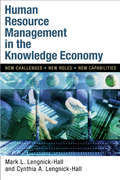
By Cyndy Lengnick-Hall, Mark Lengnick-Hall. 2006
Offers a fundamentally new conceptual model for the human resource function to meet the challenges of the knowledge economy Provides…
concrete suggestions for implementing this model, including numerous examples of effective practices from leading-edge firms Synthesizes current thinking on knowledge management and intellectual capital and identifies how human resource management can make a value-added contribution As more organizations recognize the importance of intellectual capital and knowledge management to competitive success, you would expect human resources (HR) to move to the forefront of organizational leadership. Yet, to the contrary, HR continues to be criticized for its operational and bureaucratic focus and its inability to keep up with changes in the environment. Human Resource Management in the Knowledge Economy examines how human resource management must change if it is to remain a vital part of the organization. The Lengnick-Halls show how HR departments can move beyond a simple operational focus on attracting, selecting, developing, retaining, and using employees to a more strategic focus on managing human capital and managing knowledge. The book identifies the most important features of the knowledge economy and details four new roles HR must adopt in order to help organizations succeed in this new environment: human capital steward, knowledge facilitator, relationship builder, and rapid deployment specialist. Each of these roles is defined and described in detail using examples from leading-edge businesses. Human Resource Management in the Knowledge Economy describes how human resource management has evolved and continues to evolve to meet the increasing demands of organizations for sources of competitive advantage.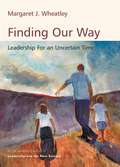
By Margaret J. Wheatley. 2010
For years, Margaret Wheatley has written eloquently about humanizing our organizations and helping people to work together more effectively and…
compassionately. She has shown how breakthroughs in chaos theory and quantum physics can enable organizations to function more like responsive, self-organizing living systems, rather than cold mechanisms of control. And she has gradually expanded these ideas into the wider arena of human society.In short, Margaret Wheatley is one of the most innovative and influential organizational thinkers of our time, and Finding Our Way brings together her shorter writings for the first time, touching on all the topics she has addressed throughout her career, showing how she has applied the ideas in her books s in many different situations. "The pieces presented here", she writes, "represent ten years of work, of how I took the ideas in my books and applied them in practice in many different situations. However, this is not a collection of articles. I updated, revised, or substantially added to the original content of each one. In this way, everything written here represents my current views on the subjects I write about." Provocative, challenging, at times poetic, and often deeply moving, Finding Our Way sums up Wheatley's thinking on a diverse scope of topics from leadership and management to education and raising children in turbulent times; from societal commentary to specific organizational techniques and more.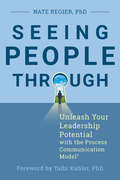
NASA, Pixar Animation Studios, and BMW all use the Process Communication Model as a way of training leaders to connect…
effortlessly with anyone. This book simplifies the complex model to make it easy for anyone to use.Today, more than ever, leaders need a new style of leadership. They are realizing that true transformation happens through meaningful relationships, and discovering that the key to sustainable connections that create possibility and potential is through communication.In Seeing People Through, we take a deep dive into The Process Communication Model (PCM), a behavioral communication model that teaches people how to assess, connect, motivate, and resolve conflict by understanding the personality types that make up a person's whole self, which is the key to leveraging personality diversity.PCM is more than a lens for understanding how people see things differently; it's a deep journey into self-awareness and self-transformation. In this book, new emerging leaders, senior leaders, and seasoned consultants alike will develop a fresh and relevant framework on leadership that is consistent with emerging trends, and they will learn how individual and collective concerns can be reconciled in leadership.NASA, Pixar Animation Studios, and BMW are just some of the companies who have all used PCM as a way to build better relationships through authenticity, trust, agility, and positive influence-and now you can, too!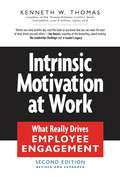
By Kenneth W. Thomas. 2009
What motivates people to do their best work in any endeavor they undertake? Management theory and practice has traditionally focused…
on elements that Kenneth Thomas calls 'extrinsic motivators': pay, benefits, status, bonuses, commissions, pension plans, expense budgets, and the like. While these are powerful motivators, particularly in command/control job situations where workers have little or no say in how the job is managed, by themselves they are no longer enough. In today's organizations, where managers expect workers and teams to self-manage their work, intrinsic rewards are essential. This breakthrough book provides the first comprehensive treatment of intrinsic motivation in the workplace-the psychological rewards workers get directly from the work itself-offering clear advice on how companies can harness its tremendous power to develop a more committed, self-managing workforce. Written in an engaging, accessible style and grounded in solid academic research, the book provides a diagnostic framework for addressing problems of intrinsic motivation and essential ways to build it.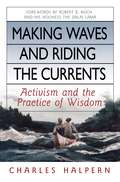
By Charles Halpern. 2008
This book is about working for a more just, compassionate, and sustainable world while cultivating the wisdom that supports and…
deepens this work. Charles Halpern is a social entrepreneur with a remarkable record of institutional innovation. He founded the Center for Law and Social Policy, the nation’s first public interest law firm, litigating landmark environmental protection and constitutional rights cases. As founding dean of the new City University of New York School of Law he initiated a bold program for training public interest lawyers as whole people. Later, as president of the $400 million Nathan Cummings Foundation, he launched an innovative grant program that drew together social justice advocacy with meditation and spiritual inquiry. In his years of activism, he had a growing intuition that something was missing, and he sought ways of developing inner resources that complemented his cognitive and adversarial skills. These explorations led him to the conviction that what he calls the practice of wisdom is essential to his effectiveness and well-being and to our collective capacity to address the challenges of the 21st century successfully. With wit and self-deprecating humor, Halpern shares candid and revealing lessons from every stage of his life, describing his journey and the teachers and colleagues he encountered on the way—a cast of characters that includes Barney Frank and Ralph Nader, Ram Dass and the Dalai Lama. Making Waves and Riding the Currents vividly demonstrates the life-enhancing benefits of integrating a commitment to social justice with the cultivation of wisdom. It is a real-world guide to effectively achieving social and institutional change while maintaining balance, compassion, and hope.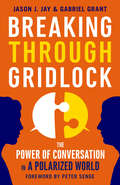
By Gabriel Grant, Jason Jay. 2017
Think about the last time you tried to talk with someone who didn't already agree with you about issues that…
matter most. How well did it go? These conversations are vital, but too often get stuck. They become contentious or we avoid them because we fear they might. What if, in these difficult conversations, we could stay true to ourselves while enriching relationships and creating powerful pathways forward? What if our divergent values provided healthy fuel for dialogue and innovation instead of gridlock and polarization? Jason Jay and Gabriel Grant invite us into a spirit of serious play, laughing at ourselves while moving from self-reflection to action. Using enlightening exercises and rich examples, Breaking through Gridlock helps us become aware of the role we unwittingly play in getting conversations stuck. It empowers us to share what really matters – with anyone, anywhere – so that together we can create positive change in our families, organizations, communities, and society.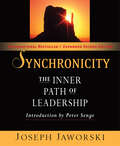
By Joseph Jaworski. 2011
Leadership is about creating new realities. In this new edition, leaders will learn how to use the power of synchronicity…
to manifest new realities into their organizations and unlock wisdom and creativity.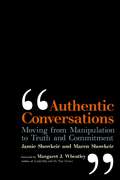
By James D. Showkeir, Maren S. Showkeir. 2008
In this groundbreaking new book, the Showkeirs take something people typically think of as merely functional—ordinary conversations—and show the power…
they have to create, sustain, and change the very nature of workplace culture. Conversations can lead to an engaged and energized workforce, or to one that is alienated and uninspired. If you want to change the culture you must change the conversations. All too often workplace conversations—between managers and direct reports, peer-to-peer, or with external stakeholders— create parent-child relationships. People hide facts, sugarcoat reality and claim helplessness to try to control interactions and get what they want. The Showkeirs expose the destructiveness of these manipulative conversations, and demonstrate how we can move to honest and authentic interactions that create adult relationships. By intentionally and thoughtfully changing conversations, organizations will engender increased commitment, true accountability, and improved workplace performance. Drawing on more than 25 years of experience as organizational consultants, their book offers examples of parent-child and adult-adult workplace conversations in a variety of settings, circumstances and industries. They also provide a hands-on guide, including sample scripts, for dealing with a host of potentially difficult conversations. Authentic Conversations goes to the heart of why so many people today are disengaged, uninspired, and uncommitted to their organization’s success. It challenges the conventional wisdom about managing people and sets out specific, concrete ways to consciously make conversations the primary driver for change.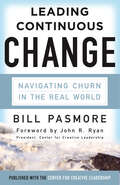
By Bill Pasmore. 2015
Most change efforts fail because most change methods are built to deal with single challenges in a nice, neat, linear…
way. But leaders know that today, pressures for change don't come at you one at a time; they come all at once. It's like riding a roller coaster: sudden drops, jarring turns, anxious climbs into the unknown. Drawing on his years of experience at the Center for Creative Leadership and Columbia University, Bill Pasmore offers a four-part model and four mindsets that allow leaders to deal with multiple changes simultaneously without drowning in the churn. The first step, Pasmore says, is to Discover which external pressures for change are the most necessary to address. The key here is to think fewer-step away from the buffet of possibilities and pinpoint the highest-impact options. Then you need to Decide how many change efforts your organization can handle. Here the mindset is to think scarcer-you have only so many people and so many resources, so how do you best use them? Once you've figured that out, it's time to Do-and here you want to think faster. Streamline processes and engage in rapid prototyping so you can learn quickly and cost-effectively. The last step is to Discern what worked and what didn't, so think smarter-develop metrics, identify trends, and make sure learnings are disseminated throughout the organization.For each stage of the process, Pasmore offers detailed advice, practical tools, and real-world examples. This book is a comprehensive guide to navigating change the way it happens now.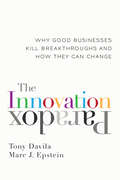
By Tony Davila, Marc Epstein. 2014
For more than twenty years, major innovations—the kind that transform industries and even societies—seem to have come almost exclusively from…
startups, despite massive efforts and millions of dollars spent by established companies. Tony Davila and Marc Epstein, authors of the bestselling Making Innovation Work, say the problem is that the very processes and structures responsible for established companies’ enduring success prevent them from developing breakthroughs. This is the innovation paradox. Most established companies succeed through incremental innovation—taking a product they’re known for and adding a feature here, cutting a cost there. Major breakthroughs are hard to achieve when everything about the way your organization is built and run is designed to reward making what already works work a little better. But incremental innovation can coexist with breakthrough thinking. Using examples from both scrappy startups and long-term innovators such as IBM, 3M, Apple, and Google, Davila and Epstein explain how corporate culture, leadership style, strategy, incentives, and management systems can be structured to encourage breakthroughs. Then they bring it all together in a new model called the Startup Corporation, which combines the philosophy of the startup with the experience, resources, and network of an established company. Breakthrough innovation no longer has to be the nearly exclusive province of the new kids on the block. With Davila and Epstein’s assistance, any company can develop paradigm-shifting products and services and maximize the ROI on its R&D.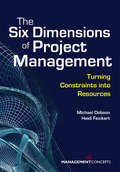
By Heidi A. Feickert, Michael S. Dobson PMP. 2007
Master the Six Dimensions of the Project Management Universe! Learn how to turn constraints into resources to achieve project objectives!…
Through case studies and practical exercises, The Six Dimensions of Project Management demonstrates the six possible combinations (or dimensions) of the "hierarchy of constraints"" (time, cost, and performance existing in a hierarchy of driver, middle and weak constraint) and the specific set of challenges and opportunities associated with each. Project managers will learn how to recognize a project's dimension and, by understanding its set of problems and resources, get the job done on time, on budget, and to spec! You will uncover hidden flexibility, unlock valuable new resources, discover threats before they turn into problems, and win the admiration of customers and projects sponsors alike. You'll learn: •How to use the "inner purpose" of a project to empower project mangers and team players•Why certain kinds of failure point the way to higher levels of success•What creates opposition to your project—and how to leverage it for your benefit•Where to look to find creative opportunities on every project